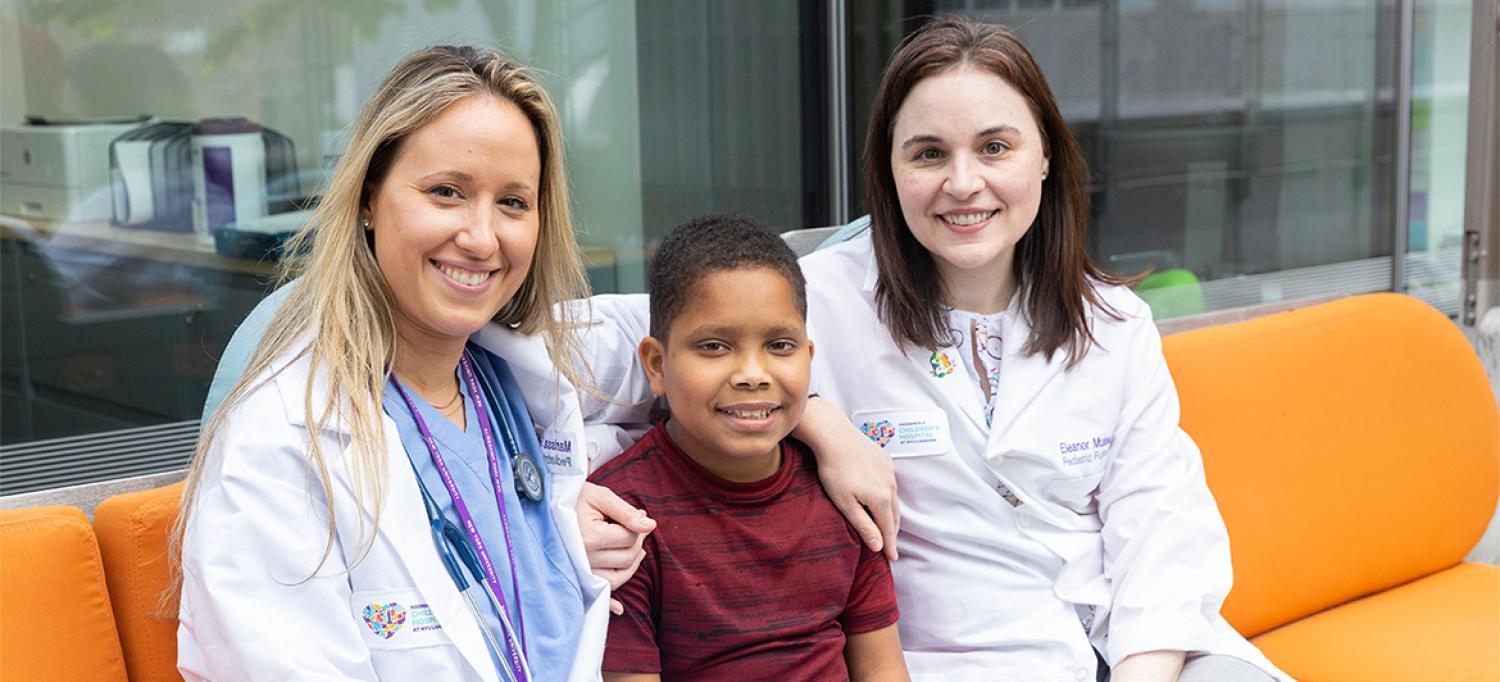
Thanks to his dedicated care team, including nurse practitioner Marissa Bernstein and pediatric pulmonologist Dr. Eleanor Muise, Darwin Del Carmen Rosso is enjoying being a teen again and catching up on things he missed out on earlier in his childhood.
Photo: NYU Langone Staff
When 16-year-old Darwin Del Carmen Rosso visited family in the Dominican Republic this summer, he didn’t have to worry about his mouth and fingernails turning purple from a lack of oxygen in his blood. And the oxygen tank he’d been tethered to is now gone.
For a teenager with severely damaged lungs, these are significant milestones. A double lung transplant at Hassenfeld Children’s Hospital at NYU Langone in 2021, followed by months of physical and occupational therapy through Rusk Rehabilitation, helped him build strength and stamina.
“Before the transplant, I wasn’t able to have a long conversation without getting tired. I had problems eating because I had to take oxygen,” the now 7th-grader says. His father, Ervin, has seen the improvement: “He can walk, he can run around, he can act like a child again.”
Transplant Is the Only Hope
Darwin doesn’t remember a time when breathing came easily. His lungs had been battered by non–cystic fibrosis bronchiectasis, a chronic and progressive respiratory condition likely caused by infection early in his life. By age 7, he had severe secondary pulmonary hypertension, a potentially life-threatening increase in blood pressure in the blood vessels in his lungs. And by the time he sought care at NYU Langone, an oxygen tank was his around-the-clock companion.
“His lungs were absolutely devastated—mucus-filled and functioning at a very poor level,” says Eleanor Muise, MD, medical director of pediatric lung transplant. “We really have a robust team to ensure the patient is an excellent candidate for transplant and to help support the patient and their family through transplant,” Dr. Muise says. Working with Luis F. Angel, MD, medical director of lung transplantation at the NYU Langone Transplant Institute, both doctors reviewed his extensive pre-transplant testing and agreed that a new set of lungs was Darwin’s best hope.
A Match Is Found
On Thanksgiving Day, Darwin got the call that he was getting new lungs. Stephanie H. Chang, MD, surgical director of lung transplantation, T.K. Susheel Kumar, MD, a pediatric cardiac surgeon, and Justin C. Chan, MD, a cardiothoracic and transplant surgeon, teamed up for the procedure. Surgery took place at Hassenfeld Children’s Hospital—34th Street, one of only two pediatric hospitals in New York State to be named a Level 1 Children’s Surgery Center by the American College of Surgeons, recognizing the hospital’s commitment to quality.
Over nearly a month-long hospital stay, Darwin received additional care for issues often seen after transplant, including infection and a complication related to medications used to prevent organ rejection.
“He can walk, he can run around, he can act like a child again.”
—Ervin Del Carmen, Darwin’s Dad
“Lung transplantation and lifelong immunosuppression require a balance of suppressing the immune system enough to ignore the transplanted organ and not so much that infections run wild,” says Dr. Muise. “Our transplant team has the experience and expertise to handle complications like the ones Darwin experienced.”
Learning to Breathe Deeply Again
While the lung transplant set him on a path to recovery, his rehabilitation would require many months of therapy. Years of struggling to get air into his lungs affected his strength and endurance. “Even something as simple as walking up a set of stairs was incredibly difficult for him in the beginning,” says Sarah Cosgrave, his physical therapist.
Cosgrave had Darwin work on building core strength and aerobic capacity. Boxing engaged his trunk and boosted his heart rate and breathing. Singing Happy Birthday while walking on a treadmill worked his lungs. She also arranged for a session of therapeutic horseback riding, called hippotherapy, in Queens. “The movement of the horse naturally makes you sit up and use your trunk for balance,” Cosgrave explains.
Rusk Rehabilitation occupational therapist Katie Ross focused on preparing Darwin to function independently without becoming fatigued. Yoga and dance, for example, helped him build endurance and taught him how to conserve energy so that he could play sports with his friends.
Darwin endeared himself to the entire care team by encouraging other children who were muddling through their own therapeutic exercises, and sometimes using his charm and wit to try getting out of his own. But now it’s time for him to get back to the business of being a teenager. Social workers and clinical psychologists, provided through Sala Institute for Child and Family Centered Care at Hassenfeld Children’s Hospital, helped with Darwin’s transition back to school. “He is working very hard in school to make up for some of the areas where he didn’t get to fully participate in his earlier childhood,” observes Dr. Muise.
“I’m interested in studying engineering and systems, and developing software and hardware,” he says. But for now, he’s enjoying playing with friends and having long conversations without getting tired, something he wasn’t able to do before. “And I thank God and the doctors for that.”

